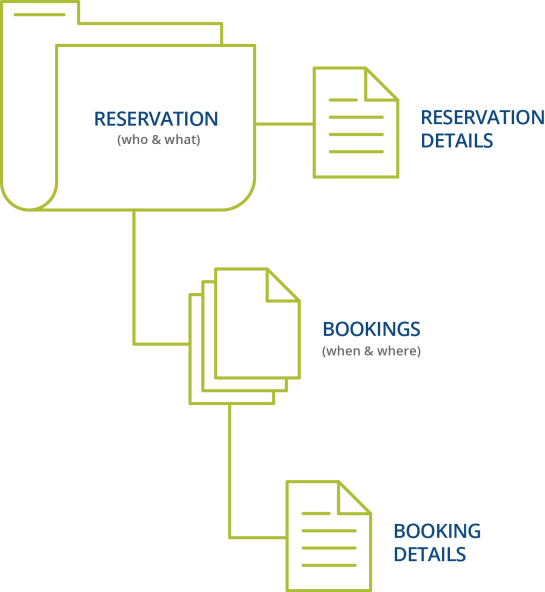Ways to Make Reservations
The EMS Web App provides several ways for you to make a new room request or event reservation:
Request a Reservation
If you logged in as a guest, you can submit a reservation request that will be approved by an authorized EMS Web App user.
Create a Reservation
Click CREATE A RESERVATION from the main menu. Then select a template to streamline the booking process and browse for available time slots and rooms.
Book Now Using Your Template
Click Book Now next to a template from your home page, and then browse for available time slots and rooms.
Browse and Then Book
Click BROWSE (main menu):
- Browse EVENTS. Then request a reservation or, if authorized, click CREATE A RESERVATION from the main menu and select a template to streamline the booking process.
OR
- Browse LOCATIONS, find the room you want, and click on any blank slot in the room's calendar. Then select a template to streamline the booking process.
First Browse and Then Book. To familiarize yourself with the locations in your organization, try Browse Events, Locations, and People before requesting rooms or making reservations. Exploring the EMS Web App this way helps you explore available space, view the schedule at a high level, and understand how other users in your organization reserve rooms. You can also establish your own naming conventions for your events and narrow down your searches to specific room types, room features, event types, geographical areas, and so on.
- Templates – Your My Account settings contain reservation Templates created by you or your Administrator to streamline the process of booking events. Rooms and workspaces are individually set to work with various types of booking templates by your Administrator.
- Requests vs. Reservations – Depending on your permissions, you may Request a Room or Make a Reservation. Room requests require approval from a more supervisory user, and are visible to other users so they know the space has been tentatively booked. The EMS Web App behaves differently for each type of user, showing fewer options (and usually, less information) for those who can only request rooms.
The Reservation Process: Who and What, Where and When
What's the difference between a "reservation" and a "booking?" A Reservation consists of one or more Bookings.
Every booking belongs to a reservation. You can have multiple bookings under a single reservation. When you have multiple bookings in a reservation, each booking can be independent of the other, such as reserving a set of rooms for an event, or can be a series of bookings under a Recurring reservation.
Each booking can contain multiple Booking Details. These are the resources and services required to support the booking, like catering and room setup.

Reservations: Who and What
A reservation is the "who and what" of an event. For example, the Academic Planning Board (who) may reserve space for a Semester Kickoff event (what).
Bookings: Where and When
A booking is the "where and when" of an event. For example, the Academic Planning Board schedules the conference room (where) for a staff meeting on the second Monday in January (when). The Academic Planning Board now has a single reservation with a single booking in EMS. If they schedule the conference room (where) for a staff meeting on the second Monday of each month for a year (when), then the board now has a single reservation with 12 bookings.
Booking Details
A booking can have one or more booking details associated with it. Booking details are the resources (items for the meeting) or services (people and their activities) needed for an event, the notes for the event, the activities for the event, the room charges for the event, or any combination of these. For example, for the Academic Planning Board’s staff meeting, the resources could include catering (coffee service, bagels and muffins, and so on) and A/V equipment, plus the services of a person bringing in and setting up a projector, moving a speaker’s podium, and so on).
Service Orders
System Administrators configure "buckets" of these details as "Categories," which streamlines the process of adding details to bookings.
In EMS, you may hear these terms used interchangeably, but they're different concepts.
A Category in EMS is anything you might add to a Booking like Catering, Audio Visual, Furniture, Security, Notes, Attendee Names, Agendas etc. When you configure a Category, it must be of six Category types: Activities, Attendees, Catering, Notes, Resources with Service Orders, or Resources Without Service Orders. These types cause the service to behave slightly differently when added to a booking. For example, a Notes/Activities/Attendees type service category does not require the EMS Administrator to configure items under it, and there is nothing for a person to “select” from these types of services.
A service category that has a type of Catering, Resource with Service Order, or a Resource without a Service Order Category, requires the Administrator to create items under it. For example, an "AV Equipment" service category (configured as a Resource without a Service Order Category type) might have items under it such as a flip chart or whiteboard (under AV Equipment). The person requesting the service for this meeting would then select AV equipment; then flip chart and whiteboard would be typical options to add to the event.
The following Category Types allow Production Items: Catering, Resources with Service Orders, and Resources Without Service Orders.
You can configure a Category to "Use States" so when a service gets requested with a meeting, it's managed through a review and approval process in the Manage Services toolbar option in EMS Desktop Client.